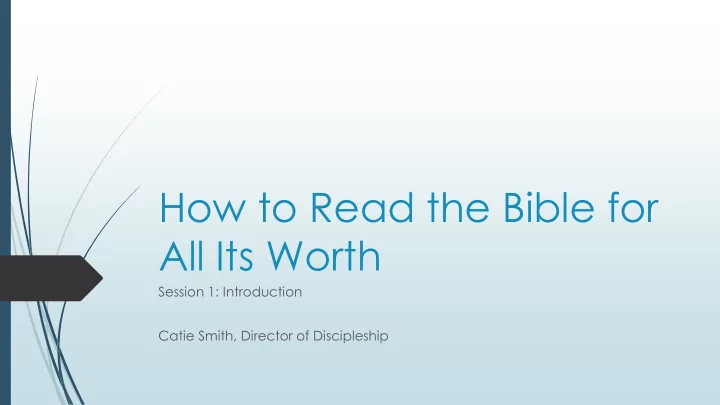

How to Read the Bible for All Its Worth Session 1: Introduction Catie Smith, Director of Discipleship
AGENDA A little about this series What is the Bible anyways? Exegesis & Hermeneutics Intro to the Epistles Readings for next week
A LITTLE ABOUT THIS SERIES…
Why this series and book? “No need to interpret; just do what it says” Interpretation is vital to our success, even today! “The aim of good interpretation is not uniqueness; we are not trying to discover what no one has seen before. The aim of good interpretation is simple: to get at the ‘plain meaning of the text.’” (17-18)
So why can’t we just read? 1. The nature of the reader
2. The nature of scripture “The Bible is the Word of God given in human words in history (dual nature)” God’s word: Eternal relevance Historical particularity
WHAT IS THE BIBLE ANYWAYS?
What is the Bible Anyways??? Special Revelation came to Human author with Holy Spirit who produced Original Manuscripts leading to Hebrew and Greek copies used to create Translations
How did the ancients recognize the books of the Bible? Ancient writings tested for Authenticity by Apostolic/prophetic origin, doctrinal soundness and consistency, and the early church acceptance/use Those that passed the test? 39 OT books (Historical, Poetic, Prophetic) 27 NT books (Narrative, Epistles, Apocalyptic)
EXEGESIS AND HERMENEUTICS
So then how do we interpret? Hear the word they heard…hear the word In the then and there(Exegesis) Hear the word in the here and now (Hermeneutics)
TASK 1: EXEGESIS Careful, systematic study of the scripture to discover the original, intended meaning Experts are needed, yes! But anyone CAN exegete a text.
What is involved in exegeting a text? Read carefully Ask the right questions Relate to CONTEXT Relate to CONTENT
Historical context Time and culture of the author Occasion and purpose of the writing Help? Use a Bible dictionary
Literary Context THE CRUCIAL TASK OF EXEGESIS Meaning of words grammatical relationships with sentences choice of original text Most important question? WHAT IS THE POINT??? So…how do we handle this? Good translation, a Bible dictionary, and good commentaries
TASK 2: HERMENEUTICS Seeking the contemporary relevance of ancient texts The Bible’s meaning in the “here and now” *The study of the Bible (exegesis) will inform our devotional (hermeneutical) reading Application is always built on interpretation, and is rooted in the gospel; glows out of gospel gratitude.
Guiding Principles The context rules when interpreting the text The text must be interpreted in light of all scripture Scripture will never contradict itself Scripture should be interpreted literally (or naturally according to its genre ) Do not develop doctrines from obscure or difficult passages Discover the author’s original intended meaning and honor that meaning Check your conclusions using reliable resources
Questions to ask… 1.Is there an example for me to follow? 8. Is there an error to avoid? 2.Is there a sin to 9. Is there a challenge to avoid/confess? face? 10. Is there a principle to 3.Is there a promise to claim? apply? 4.Is there a prayer to repeat? 11. Is there a habit to change 5.Is there a command to – i.e. start or stop? obey? 12. Is there an attitude to 6.Is there a condition to meet? correct? 7.Is there a verse to 13. Is there a truth to believe? memorize?
INTRO TO THE EPISTLES
66 books written in Hebrew Aramaic Greek We read in English (most of us) Translation understanding
THE NATURE OF EPISTLES All the NT except gospels, Acts and Revelation Types of Epistles: “Real letters” Epistle Form of ancient letters 1. Name of the writer (e.g. Paul) 2. Name of the recipient (e.g., to the church of God in Corinth) 3. Greeting (e.g., Grace and peace to you from God our Father…) 4. Prayer wish or thanksgiving (e.g., I always thank God for you…) 5. Body 6. Final greeting and farewell (e.g., The grace of the Lord Jesus be with you)
BUT They are ALL occasional documents They are ALL theology IMPLIED …
How to exegete 1 Corinthians? Homework for you Consult Bible dictionary or the introduction to your commentary to find out as much as possible about Corinth and its people. Read the entire book in one sitting (jot down notes) What you notice about the recipients Paul’s attitudes Things mentioned as to the specific occasion of the letter The letter’s natural, logical divisions **Think High School English: Who, What, When, Where, Why, How
Recommend
More recommend